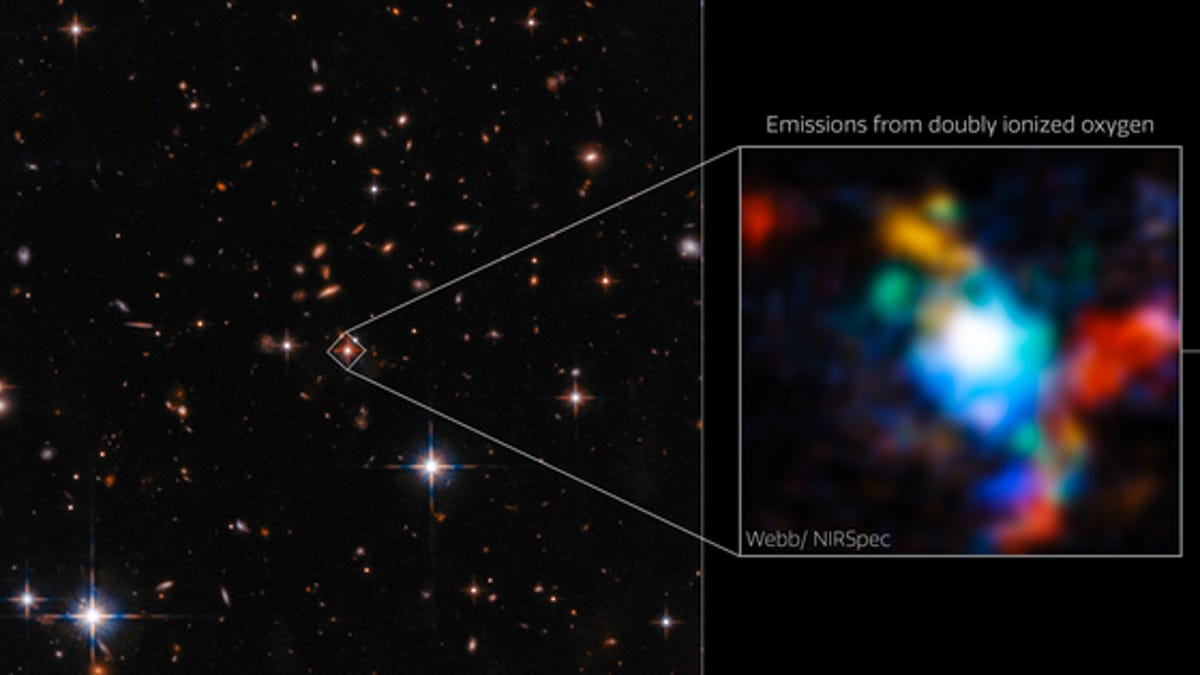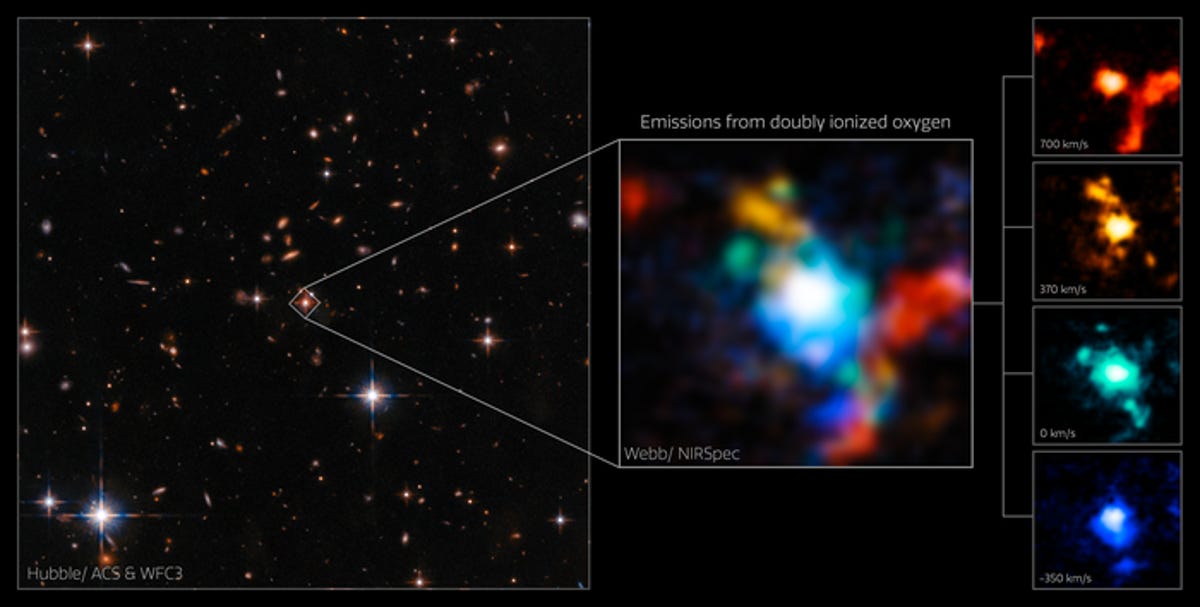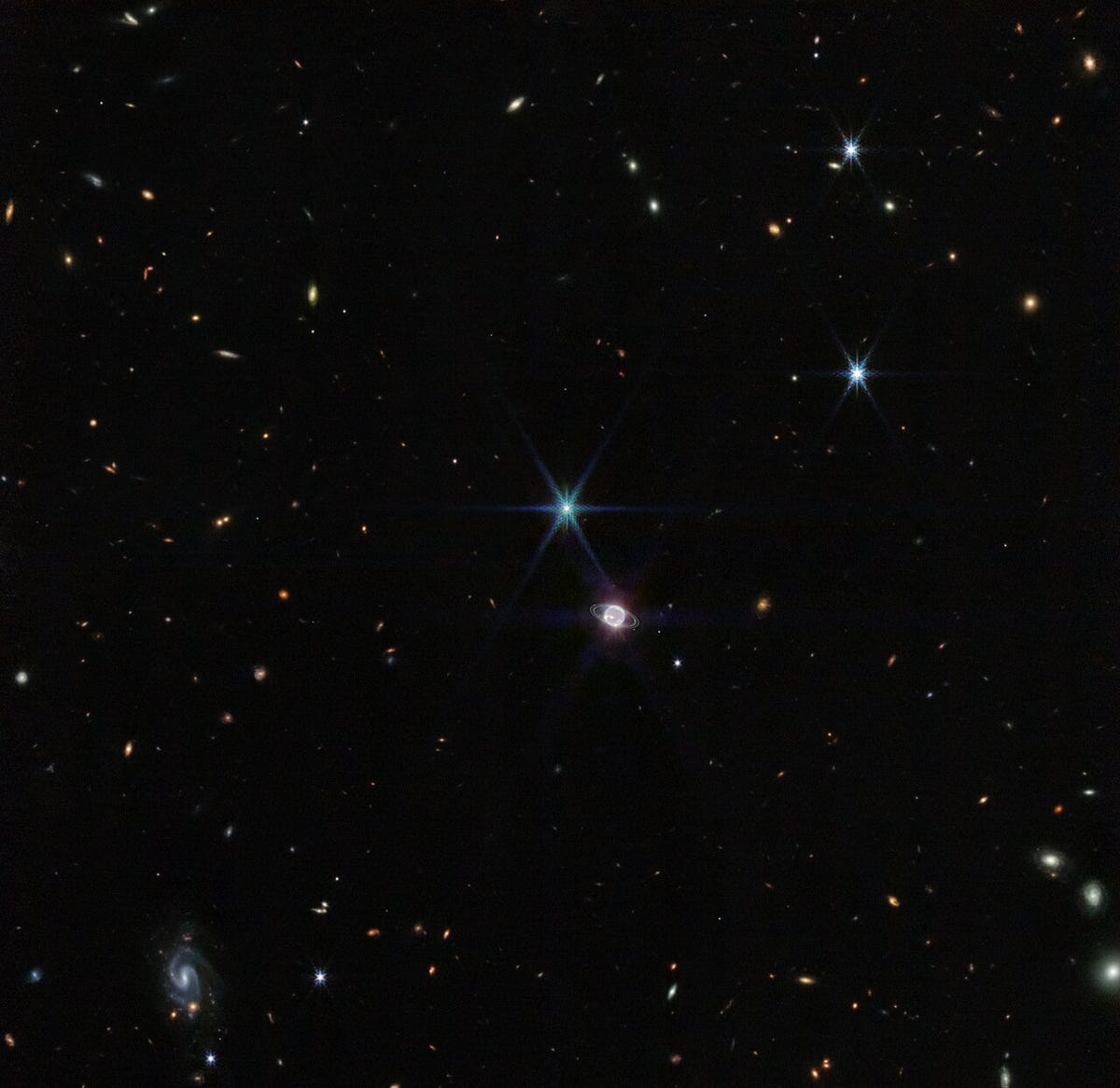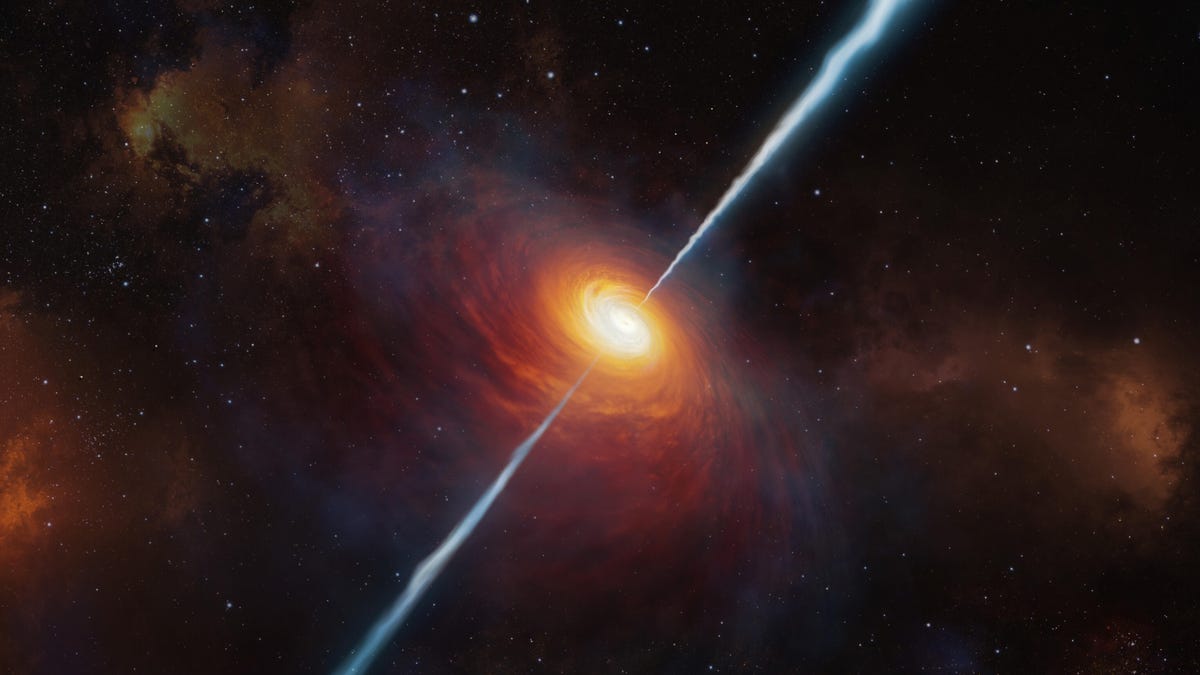
Posted on 10/24/2022 1:13:35 PM PDT by Red Badger

On the left is a Hubble image of many faraway galaxies against the dark background of space. In the middle is a blown-up portion of the Hubble image, highlighting in various colors what the JWST's view of the galaxy merger looks like. On the right, each color from the image is separated so as to show the different velocities present.
What you're looking at is evidence of a massive galaxy merger happening 11.5 billion light-years away.
ESA/Webb, NASA & CSA, D. Wylezalek, A. Vayner & the Q3D Team, N. Zakamska
Now that we have a powerful lens pointed toward the deepest regions of the universe at all times, our definition of "surprise" has slightly altered when it comes to astronomy pics.
It's no longer surprising, really, when NASA's James Webb Space Telescope reveals yet another brilliant, ancient piece of the cosmos. At this point, we know to expect nothing less from the trailblazing machine.
Instead, whenever the telescope sends back a jaw-dropping space image, it now elicits more of a "JWST strikes again!" feeling. And still, our jaws legitimately drop every single time.
This sort of dissonant version of "surprise" has happened yet again -- to a pretty extreme degree. Last week, scientists presented the JWST's brilliant view of a galaxy cluster merging around a massive black hole that houses a rare quasar -- aka an incomprehensibly bright jet of light spewing from the void's chaotic center.
There's a lot going on here, I know. But the team behind the find thinks it could escalate even further.
"We think something dramatic is about to happen in these systems," Andrey Vayner, a Johns Hopkins astronomer and co-author of a study about the scene soon to be published in the Astrophysical Journal Letters, said in a statement. For now, you can check out a detailed outline of the discovery in a paper published on arXiv.
 An artist's concept of a galaxy with a brilliant quasar at its center.
An artist's concept of a galaxy with a brilliant quasar at its center.
NASA, ESA and J. Olmsted (STScI)
Especially fascinating about this portrait is that the quasar at hand is considered an "extremely red" quasar, which means it's super far away from us and therefore physically rooted in a primitive region of space that falls near the beginning of time.
In essence, because it takes time for light to travel through space, every stream of cosmic light that reaches our eyes and our machines is seen as it was long ago. Even moonlight takes about 1.3 seconds to reach Earth, so when we peer up at the moon, we're seeing it 1.3 seconds in the past.
More specifically with this quasar, scientists believe it took about 11.5 billion years for the object's light to reach Earth, meaning we're seeing it as it was 11.5 billion years ago. This also makes it, according to the team, one of the most powerful of its kind observed from such a gargantuan distance (11.5 billion light-years away, that is).
"The galaxy is at this perfect moment in its lifetime, about to transform and look entirely different in a few billion years," Vayner said of the realm in which the quasar is anchored.
Analyzing a galactic rarity
In the colorful image provided by Vayner and fellow researchers, we're looking at several things.
 Each color in this image represents material moving at a different velocity.
Each color in this image represents material moving at a different velocity.
ESA/Webb, NASA & CSA, D. Wylezalek, A. Vayner & the Q3D Team, N. Zakamska
On the left is a Hubble Space Telescope view of the region studied by the team, and in the middle is a blown-up version of the spot that the JWST zeroed-in on. Glance to the far right of this image, where four individually color-coded boxes are seen and you'll be analyzing different aspects of the JWST data broken down by velocity.
Red stuff is moving away from us and blue toward us, for instance.
This classification shows us how each of the galaxies involved in the spectacular merger are behaving -- including the one that holds the extreme black hole and accompanying red quasar, which is, in fact, the only one the team expected to uncover with NASA's multibillion dollar instrument.
"What you see here is only a small subset of what's in the data set," Nadia L. Zakamska, a Johns Hopkins astrophysicist and co-author of the study, said in a statement. "There's just too much going on here so we first highlighted what really is the biggest surprise. Every blob here is a baby galaxy merging into this mommy galaxy and the colors are different velocities and the whole thing is moving in an extremely complicated way."
Now, Zakamska says, the team will start to untangle the motions and enhance our view to an even greater extent. Already, though, we're looking at information far more incredible than the team expected to begin with. Hubble and the Gemini-North telescope previously showed the possibility of a transitioning galaxy but definitely didn't hint at the swarm we can see with the JWST's awesome infrared equipment.

Toward the center, slightly southwest, is a glowing circle depicting Neptune. Faint rings, also glowing, are seen encircling the orb. Northwest of this globe is a six-spiked, bright bluish fixture representing one of Neptune's moons. Tons of spots and swi In another spectacular image taken by Webb's Near-Infrared Camera (NIRCam), a smattering of hundreds of background galaxies, varying in size and shape, appear alongside the Neptune system.
ESA
"With previous images, we thought we saw hints that the galaxy was possibly interacting with other galaxies on the path to merger because their shapes get distorted in the process," Zakamska said. "But after we got the Webb data, I was like, 'I have no idea what we're even looking at here, what is all this stuff!' We spent several weeks just staring and staring at these images."
Soon enough, it became clear that the JWST was showing us at least three separate galaxies moving incredibly fast, the team said. They even believe this could mark one of the densest known areas of galaxy formation in the early universe.

An artistic impression of the quasar P172+18, which is associated with a black hole 300 times more massive than the sun.
ESO/M. Kornmesser
Everything about this complex image is mesmerizing. We have the black hole, that Zakamska calls a "monster," a highly rare jet of light being spit from that black hole and a gaggle of galaxies on a collision course -- all seen as they were billions of years in the past.
So, dare I say it? The JWST strikes again, offering us an exceedingly precious cosmic vignette. Cue, jaw drop.
I know I’m asking the practically impossible to answer to my liking, it just boggles my mind that they appear to be telling us they are that good at determining what is happening billions of light years away. I mean really... Say these 2 or 3 colliding galaxies are actually millions of light years apart and due to their SIZES they appear colliding with red shift detection but in actuality they are passing one another...
Billions of stars in these galaxies and in the past 10 or 20 years were not seeing mega supernovas out of this collision? Christ if a couple super suns out with their gravitational pulls colliding with each other should light up half the universe!!
To be fair, 11.5 billion light years is a long ways away. Even a quasar or a supernova is hard to spot with a telescope. But if that were happening in our own galaxy, we’d all lose our molecular cohesion. Joe Biden could not cause that much damage, if you can believe it.
Lol... I wouldn’t make that bet!!
But don’t you need to know what color it was to begin with?
We are talking about a galaxy as it existed over 11 billion years ago, less than 3 billion years after the universe first formed. The composition of that galaxy, including the number of red, yellow and blue stars, would affect the red/blue spectrum at the source, throwing off the baseline assumptions being made to calculate the velocity using the Doppler effect.
It seems like a lot of guesswork to me.
There is an awful lot of empty space between stars in most galaxies. I suppose it is possible for two galaxies to pass through each other or to merge into one without any stars colliding, particularly when you are talking about galaxies in the early stages of the universe, that may not have existed long enough for any super sized stars to form (e.g., lots of gas, but not a lot of stars).
It’s a little more complicated than just using the wavelength of light, since there is no way to tell for certain what it started as. Spectral signatures of elements like hydrogen and oxygen form the criterion for measuring the Doppler shift, since their absorption and emission spectra are always the same, so we assume. Fortunately, it’s easy to identify elements using their spectra from any distance across the universe.
Speaking of understanding, the Milky Way Galaxy is about 100,000 light years in diameter, not millions of light years. Even in our own galaxy group which includes the massive Andromeda galaxy is only about 200,000 light years in diameter. Another in our galaxy group is M33 Triangulum Galaxy, and it only has a diameter of about 60,000 light years.
I captured this image of M33 Galaxy just last week. This object has little surface brightness and is not easy to capture. M33 is 3 million light years (18 Trillion Miles) away.

208x60 3hr/28mn
Btw, M33 above appears messed up or not too symmetrical, as it’s speculated M33 collided with Andromeda Galaxy billions of years ago.
Now that’s funny! The ruling class of the day would no doubt take full advantage of it.
Space is the final frontier for man. The knowledge gained will be critical, if man lasts long enough to escape earth's demise one day.
That’s not bad at all. I suppose I could see M33 with my 80mm binoculars as a fuzzy dot. It’s 18 quintillion miles, btw. Two really messed up galaxies are the Magellanic clouds, which were once spiral but are now irregular due to their closeness to our own.
I hear under dark skies with near perfect conditions, 33 can just be seen with the unaided eye.
Maybe at high altitude too. No way near city lights.
“Now that’s funny! The ruling class of the day would no doubt take full advantage of it.”
Never let an emergency go to waste. And that would be the mother of all emergencies.
Disclaimer: Opinions posted on Free Republic are those of the individual posters and do not necessarily represent the opinion of Free Republic or its management. All materials posted herein are protected by copyright law and the exemption for fair use of copyrighted works.